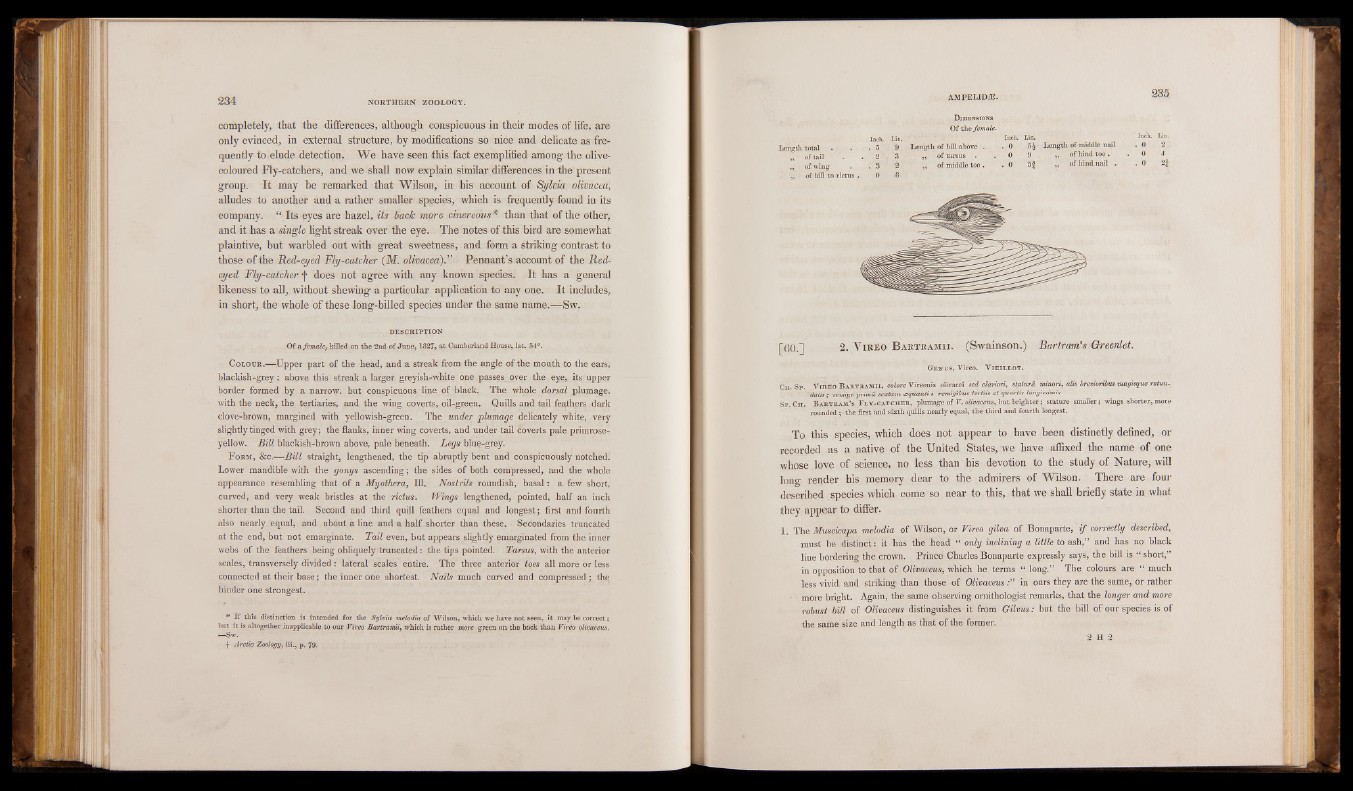
completely, that the differences, although conspicuous in their modes of life, are
only evinced, in external structure, by modifications so nice and delicate as frequently
to elude detection. We have seen this fact exemplified among the olive-
coloured Fly-catchers, and we shall now explain similar differences in the present
group. It may be remarked that Wilson, in his account of Sylvia olivacea, alludes to another and a rather smaller species, which is frequently found in its
company. “ Its eyes are hazel, its back more cinereous* than that of the other,
and it has a single light streak over the eye. The notes of this bird are somewhat
plaintive, but warbled out with great sweetness, and form a striking contrast to
those of the Red-eyed Fly-catcher (M . olmacea).'i'. Pennant’s account of the Redeyed
Fly-catcher f does not agree with any known species. It has a general
likeness to all, without shewing a particular application to any one. It includes,
in short, the whole of these long-billed species under the same name.—Sw.
~ DESCRIPTION
Of a female, killed on the 2nd of June, 1827, at Cumberland House; lat. 540.'„ ,,;
C olo u r .—Upper part of the head, and a streak from the angle of the mouth to the ears,
blackish-grey: above this streak a larger greyish-white one passes over the eye, its Upper
border formed by a narrow, but conspicuous line of black. The whole dorsal plumage,
with the neck, the tertiaries, and the wing coverts, oil-green. Quills and tail feathers dark
clove-brown, margined with yellowish-green. The under plumage delicately white, very
slightly tinged with grey; the flanks, inner wing coverts, and under tail coverts pale, primrose-
yellow. Bill blackish-brown above, pale beneath. Legs blue-grey.
F orm, &c .— Bill straight, lengthened, the tip abruptly bent and conspicuously notched.
Lower mandible with the gonys ascending; the sides of both compressed, and the whole
appearance resembling that of a My other a, 111. Nostrils roundish, basal: a few short,
curved, and very weak bristles at the rictus. Wings lengthened, pointed, half an inch
shorter than the tail. Second and third quill feathers equal and longest; first and fourth
also nearly equal, and about a line and a half shorter than these. Secondaries truncated
at the end, but not emarginate. Tail even, but appears slightly emarginated from the inner
webs of the feathers being obliquely truncated: the tips pointed. Tarsus, with the anterior
scales, transversély divided : lateral scales entire. The three anterior toes all moré or less
connected at their base; the inner one shortest. Nails much curved and compressed; the
hinder one strongest.
* If this distinction is intended for the Sylvia melodia of Wilson, which we have not seen, it may be correct;
but it is altogether inapplicable to our Vireo Bartramii, which is fathér more green on the —Sw. back than Viréo olivaceus.
f Arctic Zoology, iii., p. 79.
Dimensions
Of the female.
Inch. Lin. Inch. Lin. ‘ Inch. Lin.
total 9 Length of bill above . . 0 Length of middle nail . 0 2.;
of tail ' 2 > 3 „ of tarsus . 0 9 „ of hind toe. . 0 4
of wing : 3 ;:' 2 „ of middle toe . . 0 5f ^ of hind nail . . 0
of bill to rictus . 0 8
[60.] 2. V ir e o B a r t r a m ii. (Swainson.) Bar tram's Greenlet.
Ge n u s , Vireo. V ie il l ó t .
Ch . Sp . Vir e o B a r t r a m ii, colore Vireonis olivacei sed clarion, statura minori, alis brevioribus magisque rotun-
datis; remige prima sextain cequanti: remigibus tertiis et quartis longissimis.
Sp . Ch . B e r t r a m ’s F ly -c a t c h e r , plumage of V. olivaceus, but brighter; stature smaller; wings shorter, more
rounded ; the first and sixth quills nearly equal, the third and fourth longest.
To this species, which does not appear to have been distinctly defined, or
recorded as a native of the United States, we have affixed the name of one
whose love of science, no less than his devotion to the study of Nature, will
long render his memory dear to the admirers of Wilson. There are four
described species which come so near to this, that we shall briefly state in what
they appear to differ.
1. The Musdcapa melodia of Wilson, or Vireo gilva of Bonaparte, if correctly described,
-must be distinct: it has the head “ only inclining a little to ash,” and has no black
line bordering the crown. Prince- Charles Bonaparte expressly says, the bill is “ short,”
in opposition to that of Olivaceus, which he terms “ long.” The colours are “ much
less vivid, and striking- than those of O liva ceu sin ours they are the same, or rather
more bright. Again, the same observing ornithologist remarks, that the longer and more
robust bill of Olivaceus distinguishes it from Gilvus: but the bill of our species is of
the same size and length as that of the former.